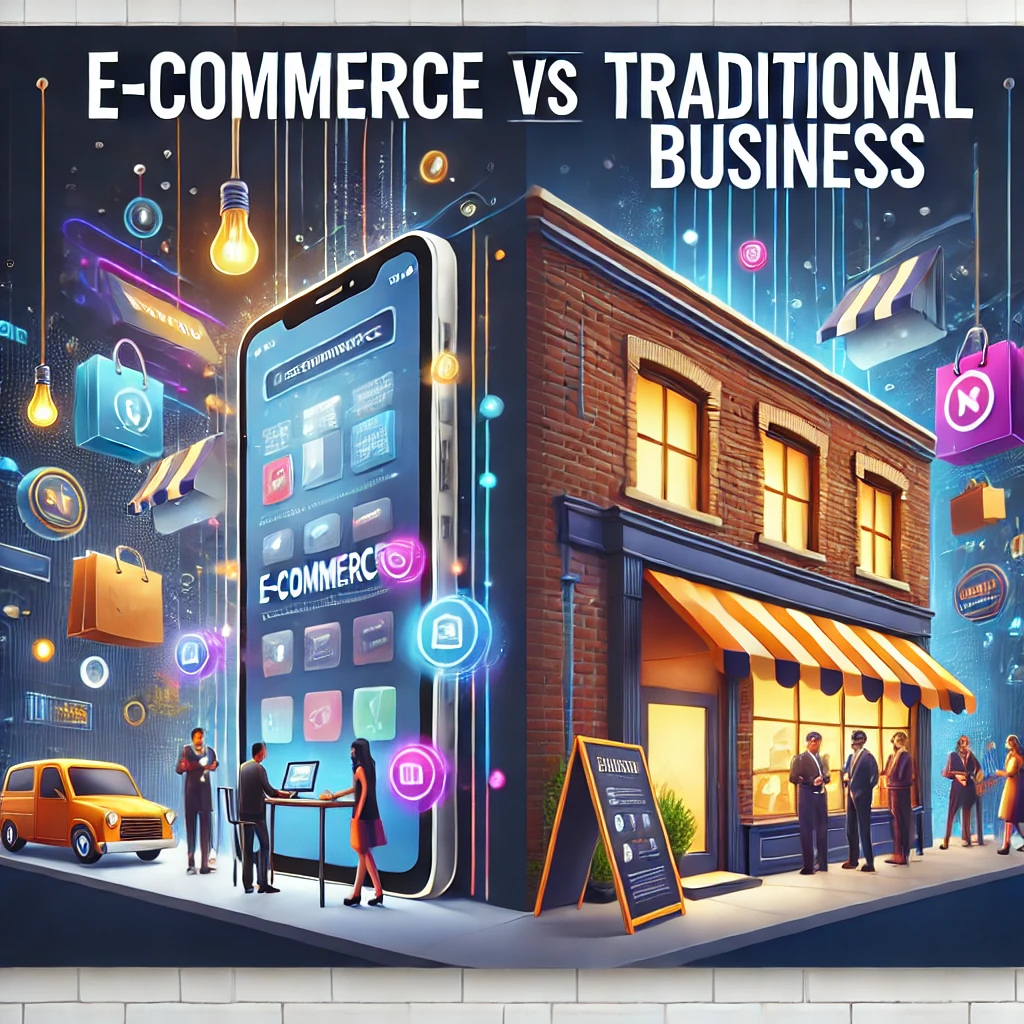The rapid rise of e-commerce has dramatically reshaped the retail landscape, challenging traditional businesses that have long relied on brick-and-mortar models. As consumers increasingly turn to online shopping for convenience, variety, and competitive pricing, traditional retailers face growing pressure to adapt or risk becoming obsolete. I am sure you have noticed the change in your local apparel stores or cosmetic store and their declining sales. While online commerce is great for people but it also possess a risk to small traders. Let’s see how they can adapt in this changing environment.
The Impact of E-commerce on Traditional Businesses
1. Shift in Consumer Behavior
E-commerce has revolutionized how consumers shop, offering them the ability to browse and purchase products from the comfort of their homes, often at any time of day. This shift has been driven by several factors:
- Convenience: E-commerce platforms allow consumers to shop without the limitations of geography or store hours. The ease of browsing online catalogs, comparing prices, and making purchases with a few clicks is unmatched by traditional retail.
- Variety and Availability: Online stores can offer a wider range of products than physical stores due to the lack of space constraints. This variety, coupled with the ability to easily search and filter products, provides a superior shopping experience for many consumers.
- Price Sensitivity: E-commerce has made price comparison incredibly easy. Consumers can quickly compare prices across multiple online stores, often leading to more competitive pricing and driving traditional retailers to match or lose customers.
These changes in consumer behavior have put significant pressure on traditional businesses, especially those that have been slow to embrace digital transformation.
2. Decline in Foot Traffic and Sales
As more consumers opt for online shopping, physical stores have seen a decline in foot traffic. This reduction in in-store customers has had a direct impact on sales, particularly for retailers that rely heavily on impulse purchases or experiential shopping. Department stores, malls, and small independent retailers have been particularly affected, with many struggling to maintain profitability in the face of declining sales.
3. Increased Competition
E-commerce has lowered the barriers to entry for new businesses, leading to an influx of online-only retailers. These new entrants often operate with lower overhead costs, allowing them to offer competitive pricing and attract price-sensitive customers. Traditional businesses now find themselves competing not just with local rivals but with global online retailers who can deliver products quickly and often at lower prices.
Adapting to the E-commerce Revolution
For traditional businesses to survive and thrive in the age of e-commerce, they must adapt to the changing landscape. Here are several strategies that can help:
1. Embrace Omnichannel Retailing
One of the most effective ways for traditional businesses to compete with e-commerce is by adopting an omnichannel approach. This strategy involves integrating both online and offline channels to provide a seamless shopping experience. Key components of omnichannel retailing include:
- Online Presence: Traditional businesses must establish a strong online presence, either through their own e-commerce platforms or by partnering with established online marketplaces. This allows them to reach a broader audience and capture online sales.
- In-Store and Online Integration: Offering services like “buy online, pick up in-store” (BOPIS) or “reserve online, try in-store” can help bridge the gap between physical and digital shopping experiences. This not only drives foot traffic to physical stores but also caters to consumers’ desire for convenience.
- Consistent Branding and Customer Experience: Ensuring that customers have a consistent experience across all channels is crucial. Whether shopping online or in-store, customers should encounter the same branding, product availability, and customer service quality.
2. Leverage Technology
Traditional businesses can leverage technology to enhance their operations and customer experiences. Several technologies are proving to be game-changers:
- Mobile Commerce: With the rise of smartphones, mobile commerce (m-commerce) has become an essential part of the retail ecosystem. Traditional businesses should invest in mobile-friendly websites or apps to capture the growing number of consumers who shop on their phones.
- Artificial Intelligence (AI) and Personalization: AI can help businesses analyze customer data to provide personalized recommendations and offers. Personalization has become a key driver of customer loyalty, as consumers increasingly expect tailored experiences.
- Augmented Reality (AR): AR allows customers to visualize products in their own environment before making a purchase. For example, furniture retailers can use AR to let customers see how a sofa would look in their living room, blending the benefits of online and in-store shopping. Almost all business now has AR features in their shopping apps, through which you can see how the product might look in your room. This gives people an idea about the size and look of the product before buying.
3. Enhance the In-Store Experience
While e-commerce offers convenience, traditional stores can provide an experience that online shopping cannot replicate. By enhancing the in-store experience, businesses can differentiate themselves and attract customers. Strategies include:
- Experiential Retail: Creating a unique in-store experience, such as product demonstrations, workshops, or special events, can draw customers to physical locations. For example, beauty retailers often offer in-store makeup consultations, which provide value beyond the product itself.
- Customer Service Excellence: High-quality, personalized customer service can be a significant competitive advantage for traditional retailers. Offering expert advice, assistance, and post-purchase support can create a loyal customer base that values the in-person experience.
- Loyalty Programs: Implementing a loyalty program that rewards customers for both online and in-store purchases can encourage repeat business. By offering incentives, traditional businesses can maintain customer engagement across channels.
4. Streamline Operations and Supply Chain
E-commerce has set a high standard for speed and efficiency in delivery. Traditional businesses must streamline their operations and supply chain to meet these expectations. Key areas of focus include:
- Inventory Management: Implementing advanced inventory management systems can help businesses maintain optimal stock levels, reduce costs, and improve fulfillment speed. Real-time inventory tracking also ensures that customers have accurate information about product availability.
- Efficient Logistics: Partnering with reliable logistics providers or investing in in-house delivery solutions can help traditional businesses offer faster and more cost-effective shipping options. Same-day or next-day delivery services can be a significant competitive advantage.
5. Collaborate and Innovate
Finally, traditional businesses should explore opportunities for collaboration and innovation. Whether partnering with online retailers, exploring new business models, or investing in emerging technologies, innovation is key to staying relevant in the rapidly changing retail landscape.
- Partnerships: Collaborating with e-commerce platforms or even other traditional businesses can provide access to new customer bases and resources. For instance, a local retailer might partner with a global online marketplace to expand their reach.
- Subscription Models: Exploring new revenue streams, such as subscription services, can help traditional businesses generate steady income and build customer loyalty. For example, a clothing retailer might offer a subscription box with curated outfits delivered monthly. Most of these ideas have already been implemented in the western countries so it shouldn’t be difficult to implement these.
Conclusion
The rise of e-commerce has undeniably disrupted traditional retail, but it also presents opportunities for businesses willing to adapt. By embracing omnichannel strategies, leveraging technology, enhancing the in-store experience, streamlining operations, and fostering innovation, traditional businesses can not only survive but thrive in the digital age. The key is to remain flexible, customer-focused, and open to change as the retail landscape continues to evolve.
Other interesting articles for you:




Leave a Reply